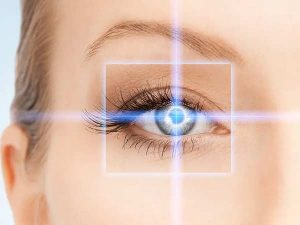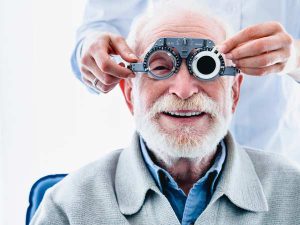
What is Keratoconus?
Keratoconus is a non – inflammatory, degenerative disease of the cornea. Changes in the structure of the cornea make it thinner, modifying its curvature, thus giving it a more conical shape (ectasia) than normal (see photos above).
To better understand what keratoconus is in the eyes, look at the figure above. Look at the image on the left and see the typical curvature of a normal cornea. As you can see in the eye with keratoconus, the curvature of the cornea is modified and consequently, the images, when passing through the cornea, are distorted, causing changes in the vision of people with keratoconus (image on the right). Corneal changes induce myopia and myopic astigmatism. Myopia and astigmatism are two types of refractive errors.
Ocular keratoconus is the most common corneal dystrophy. It is a disease that affects one individual in every thousand. This disease occurs in populations all over the world, however, some ethnic groups have a higher prevalence than others. It is usually diagnosed in adolescent patients (2nd decade of life) with the most severe stage in the second and third decades of life.
The disease can affect just one eye or both eyes. Bilateral keratoconus (in both eyes) is more common than unilateral keratoconus (keratoconus in only one eye).
Keratoconus is a serious disease as it progresses to significant loss of visual acuity. In advanced stages, the patient may even go blind.
Symptoms of keratoconus
The most common symptoms of keratoconus are the perception of multiple ghost images (monocular polyopia). These symptoms are more evident in high-contrast fields of view. The keratoconus patient sees many dots scattered in a very irregular pattern. This pattern usually does not change, but it can take on new forms over time. In some cases, monocular diplopia may be present (presence of double instead of multiple images). Keratoconus often causes headaches, due to the strain on the eyes that the patient has to do to see.
Usually, keratoconus causes substantial changes in vision such as: hypovision (low vision), diplopia (perception of two images) or polyopia (multiple images) and exaggerated sensitivity to light (photophobia).
Symptoms usually worsen as the disease progresses. Keratoconus can blind, that is, it can lead to blindness in the advanced stages of the disease.
Keratoconus Diagnosis
The diagnosis of keratoconus is made by clinical observation and through complementary diagnostic tests. The most used examination in the diagnosis of keratoconus is corneal topography. Corneal topography is an eye exam that allows the evaluation of gross or incipient anomalies on the anterior or posterior surface of the cornea, allowing the diagnosis of keratoconus and other pathologies to be made.
Causes of keratoconus
The causes of keratoconus are still not completely understood. It is known that “rubbing or scratching the eyes” can help with the evolution of keratoconus, so it is important to avoid these gestures. It is also known that, usually, keratoconus evolves during pregnancy.
Degrees of keratoconus
We can identify the following degrees of keratoconus:
Grade 1 – incipient keratoconus is the first degree of keratoconus. At this stage, vision is preserved and refractive errors (myopia and myopic astigmatism) are small.
Grade 2 – grade 2 keratoconus is the next phase in which the patient already reports some hypovision and needs glasses or contact lenses to correct the resulting refractive errors.
Grade 3 – grade 3 keratoconus is an advanced stage of the disease in which vision, even with optical correction, is already quite affected, and may require surgical correction, namely, intrastromal rings.
Grade 4 – Grade 4 keratoconus is the most advanced stage where we can find leukomas (corneal opacity) or edema (hydrops). The only form of treatment is corneal transplantation.
Does Keratoconus have a cure?
There is no cure for keratoconus, however, if treated properly it can restore good visual acuity compatible with the needs of daily tasks.
Keratoconus can and should be operated on, adjusting the surgical technique to the type and stage of keratoconus. When glasses or contact lenses do not correct visual acuity to acceptable values and before the cornea becomes cloudy (hydrops), the currently most accepted technique is the implantation of rings in the thickness of the cornea, according to the type and stage of keratoconus. The results are extremely encouraging.
In extreme situations of hydrops, the surgical method of choice is corneal transplantation.
Keratoconus treatment
The two forms, most used in the treatment of keratoconus, are:
1st Treat the hypovision caused by keratoconus through glasses in the initial phase of the disease and when the use of glasses does not produce the desired effects, the use of contact lenses for keratoconus should be tried, namely, semi-rigid or rigid contact lenses.
Contact lenses for keratoconus should be semi-rigid or rigid depending on the stage (incipient or advanced keratoconus), type of keratoconus and the adaptability of the patient. Each patient has a different sensitivity to adapt to contact lenses. While for one person adaptation may be easy, for another, adaptation may prove to be quite complicated.
2nd Another form of keratoconus treatment is to treat the pathology, that is, resorting to surgery, namely, by placing corneal rings in the corneal stroma in order to modify its curvature, thus obtaining excellent visual results. When the cornea has no physical conditions or is very conical or cloudy, what is indicated is a corneal transplant, in order to restore the transparency of the optical means.
Corneal ring surgery is usually performed with two types: Paulo Ferrara rings (Ferrara ring) and INTACS.
Ferrara ring and INTACS
As we have seen, corneal ring surgery can be performed using Paulo Ferrara rings (ferrara ring implant) or by INTACS.
The difference between the two methods is that the former has a smaller radius of curvature, that is, they are smaller than INTACS.
The use of one or the other will be defined by the experience of the ophthalmologist, and by the conditions and location of the keratoconus, since it can be central, inferotemporal (the most frequent) or superior (the least frequent).
To learn more about corneal ring placement surgery, see keratoconus surgery and learn about the main advantages of this surgery when compared to corneal transplantation.
Corneal Crosslinking
Currently, there are new treatments for keratoconus, with corneal crosslinking being one of those that have shown the best results, allowing to an increase in the rigidity of the cornea.
This keratoconus treatment is performed using a type of laser (UV light) on a cornea that has been previously showered with riboflavin (vitamin B2).
Most of the cornea is made up of type IV collagen fibers. These fibers are grouped in parallel and perpendicular layers. Riboflavin is a compound that is present in our body and absorbs UV light. By applying riboflavin to the cornea, and associating it with UV light, we managed to increase the rigidity of the cornea, stabilizing ectasia.
Over time, the cornea becomes progressively more rigid (Crosslinking).
Keratoconus surgery
Keratoconus surgery can be performed by placing corneal rings in the corneal stroma in order to correct its curvature. Keratoconus surgery with implantation of an intrastromal ring or corneal rings has lower intra and postoperative risks and complications, and faster recovery, among other advantages, when compared with corneal transplantation. In patients with keratoconus, the surgical results obtained with intrastromal ring implantation are very good and usually better than those achieved with corneal transplantation, for several reasons:
- Visual acuity after corneal rings is usually higher than expected in corneal transplantation;
- Refractive errors after an intracorneal ring are much smaller than after corneal transplantation and recovery is much faster;
- Ring surgery is reversible, whereas transplant surgery is irreversible, and corneal decompensation may occur after a few weeks or after 20 years, for example;
- Surgery for keratoconus with corneal rings is easier than transplantation, it can be performed under local anesthesia and recovery is much shorter, although it is not free of complications or intra- or postoperative risks;
- Corneal ring surgery has advantages over transplantation even if we consider the ages of these patients, who are generally young people, not subject to corneal decompensation;
- Ring surgery is an extra-ocular surgery, while corneal transplantation is open surgery, subject to some serious complications, namely, choroidal haemorrhage, retinal detachment, endocular infection (endophthalmitis), secondary cataracts, secondary glaucoma, synechiae of the iris, pupillary irregularity, cystoid macular edema, etc.
- Although the results of surgery with rings are encouraging, this result is only possible with a lot of experience, a good anamnesis, good and adequate complementary diagnostic exams, a good surgical plan and a perfect surgical technique, free from errors;
- It should be noted that the results achieved with the placement of an intrastromal ring are good, although there may be some post-surgical complications, namely, ring extrusion in traumatic situations or corneal ulcers.
When there are no conditions for this operation, what is indicated is a corneal transplant.
How much does surgery cost?
The price of keratoconus surgery may vary according to the surgical technique, subsystem or health insurance associated with the patient, etc.
After evaluating the patient in the consultation, the Ophthalmologist will be able to define the surgical plan and estimate the cost of the surgical intervention.

 See in the second photo a chalazion on the inner face (internal chalazion).
See in the second photo a chalazion on the inner face (internal chalazion).














 It is eye surgery that permanently changes the shape of the cornea (the clear covering at the front of the eye). This is done to improve vision and reduce the person’s need to wear glasses or contact lenses.
It is eye surgery that permanently changes the shape of the cornea (the clear covering at the front of the eye). This is done to improve vision and reduce the person’s need to wear glasses or contact lenses.

